The iPhone 7 and iPhone 7 Plus Review: Iterating on a Flagship
by Joshua Ho & Brandon Chester on October 10, 2016 8:00 AM EST- Posted in
- Smartphones
- Apple
- Mobile
- iOS
- iOS 10
- iPhone 7
- iPhone 7 Plus
Battery Life
As-is, one of the most important factors for upgrading a smartphone remains battery life, due to a combination of inherent demand for a phone that can last 2-3 days of use and applications that demand enormous amounts of performance over long periods of time. Apps like WeChat are fairly notorious for holding wakelocks on Android and never really stopping background resource usage so there’s also an element of OS optimization that goes with keeping real-world in battery life up to expectations.
In order to test these things, we’ve spent the past year developing and validating a new web browsing battery life test which updates the sites used and introduces a scrolling component which attempts to better model how a number of tasks are not simply race to sleep and contain a steady-state component. We’ve also updated our rundown tests to better reflect reality and maintain appropriate loads as some devices with high-end SoCs and low display resolution were outpacing our testing. As always, all displays are set to 200 nits with location and other background services disabled to reach a useful relative comparison.

Looking at our WiFi web browsing test, it’s genuinely ridiculous how well the iPhone 7 and 7 Plus perform in this test. The iPhone 7 Plus is definitely down on battery life compared to the Galaxy S7 Edge, but it’s within 5% despite using a battery that’s almost 20% smaller. The iPhone 7 is actually comparable in battery life to the iPhone 7 Plus, and is significantly above the Galaxy S7 with Exynos 8890. Of course, the iPhone 7 has a significantly lower resolution display and a smaller battery, but the nature of smartphone design is that larger devices will generally have better battery life because the board area needed remains mostly constant while the amount of area for battery increases. The iPhone 7 has significantly improved in battery life here, likely due to a combination of A10 Fusion's power optimizations – particularly the small CPU cores – and the removal of the headphone jack, which teardown photos show to have been partially replaced with the battery. However if you do the math efficiency sees a relatively minor uplift.
One other interesting point is that Brandon accidentally ran the battery test on his iPhone 7 with a Safari Content Blocker enabled, which blocked all the ads on the sites that the test visits. In doing so, battery life rose from the normal result of 9.22 hours to 10.03 hours, demonstrating how the increased workload and long-running network requests from ads and trackers really impacts a smartphone's battery life. It's also worth noting that our test constantly cycles through pages, so if you spend a lot of time on a single page with ads you could see an even greater difference.
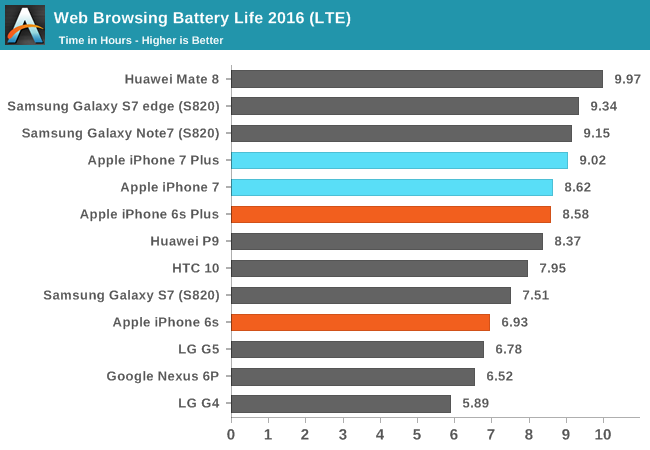
Moving on to LTE battery life the iPhone 7 and 7 Plus both slip a bit, but remain impressive. I suspect that the 20nm Qualcomm modem here is not well-equipped to handle the endless stream of ads that is increasingly a part of most websites. As ads tend to stream in incredibly slowly, the standby power of the modem is a significant factor. Snapdragon 820 devices don’t see nearly the impact here that the iPhone 7 and 7 Plus as their modem is on 14LPP rather than 20SoC. The iPhone 7 remains above the S820 Galaxy S7, but the iPhone 7 Plus is fairly comparable to the iPhone 6s Plus in battery life on LTE.

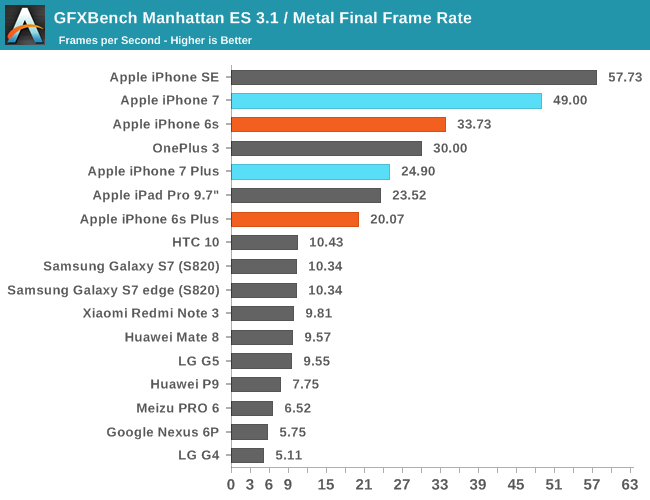
Moving past the web browsing test we use we can take a look at how the iPhone 7 Plus throttles. Unfortunately Basemark OS II was basically broken in this regard for the CPU rundown test so we can only look at how it behaves on Manhattan 3.1, but it's interesting to see how the GPU performance drops about 40% for the iPhone 7 Plus while the iPhone 7 throttles around 20%, because even Manhattan 3.1 is pegged to vsync which means that the GPU can spend much more time idling once a given frame is rendered. It's probably not a surprise here but the iPhone 7 just doesn't last very long here because battery life is strongly SoC-bound. If you attempted to plot battery life as a function of overall SoC utilization, it's entirely possible that the iPhone 7 might last longer than the 7 Plus at the lower bound for utilization, but as soon as you go past web browsing and similarly "light" tasks the 7 Plus and most phablets are going to strongly outperform such a small phone. Here the larger battery helps to get the iPhone 7 Plus nearly another hour of battery life when the SoC is under full, continuous load.
Charge Time
As usual, while battery life is the salient characteristic that determines overall mobility, it’s important to not ignore charge time as there are a number of edge cases where charging has a significant impact on overall mobility. In order to test this we use power measurements at the wall and measure the time it takes from the moment that the charger is plugged in to the moment that it falls below a pre-determined draw from the wall. While this isn’t perfect due to varying levels of DC conversion efficiency and different methods of trickle charging, this method provides at least a reasonable approximation of how long it will take to charge a device.
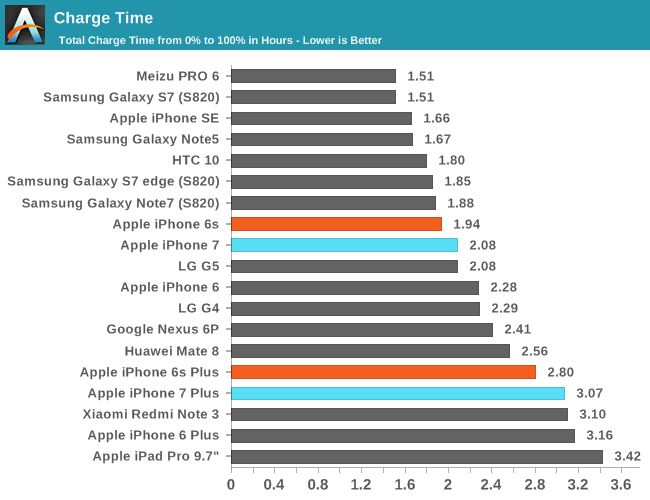
In the case of the iPhone 7 and 7 Plus, Apple continues to ship their standard 5W chargers for US variants. Looking at the results, it’s probably obvious that at least in the case of the iPhone 7 Plus, there is a very real need for Apple to start shipping something with faster charging, as the standard 5W charger takes a full hour longer than most of its competition to charge to 100%. Even the iPhone 7 could use a higher power charger here as using the device while it is charging will significantly impact the charging rate as the charger cannot supply enough power to the board while also charging the battery. And in the case of both phones, the lack of a high power charger doesn't just draw out the total charge time, but it also precludes rapid charging (partially charging a depleted phone very quickly) as well.
It would really be prudent for Apple to start to transitioning to higher power AC adapters at this point. This doesn’t take away from how impressive battery life is, but overall mobility isn’t going to be better than the competition unless you go out of your way to buy an iPad charger.


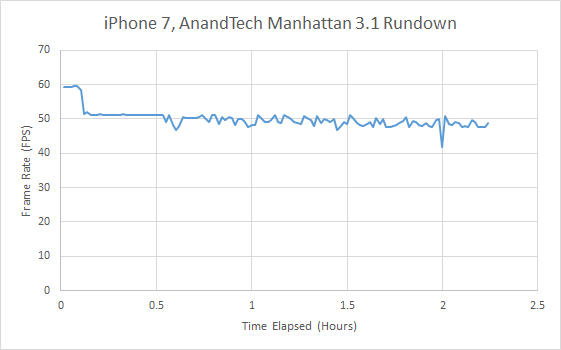
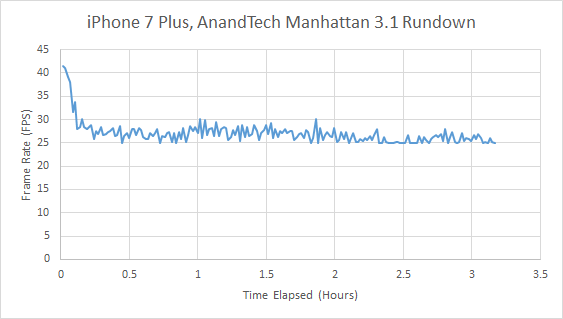
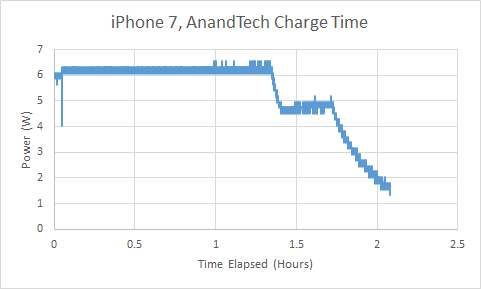
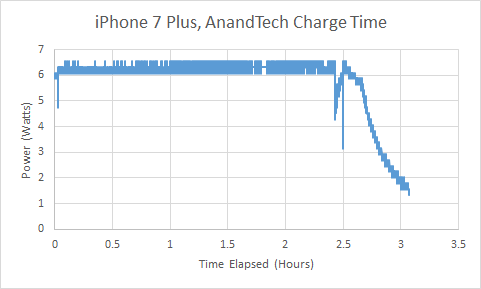








377 Comments
View All Comments
tuxRoller - Thursday, October 13, 2016 - link
Oh yes, AnTuTu. What does that do again? How does it do it?Geekbench is SLIGHTLY better as it explains, at a fairly high level, how each test is performed. It even lets you know that they are preference apple by using llvm everywhere.
None of these are worth respecting reporting on, however, unless the benchmarks are open source.
Ranger1065 - Wednesday, October 12, 2016 - link
The old Anandtech...maybe :)Dribble - Monday, October 10, 2016 - link
If you like your wireless headphones that's great, but don't try to sell me that ONLY having them is somehow fine. It's not like you couldn't use wireless for iphone 6 and now suddenly you can. Sometimes wired is better - e.g. phone in the car, you are charging phone and plugging into the jack to play music off it. You don't want to have to take some silly adaptor dongle everywhere with you in case you need wired (that's a bad user experience).It would also have been more honest to say why they removed it - it's not for some mythical extra space to add other stuff like you suggested, its 100% to make more $$$. Irrespective of who designs or makes it anything that plugs into apples proprietary jack has to pay apple money because they own the copyright. They don't own any copyright on the 3.5mm jack. Hence they removed the jack to force devices to use apples jack and hence pay them more money (something we the consumer end up paying for).
solipsism - Monday, October 10, 2016 - link
1) Cars with BT have been on the market for over a decade, it comes with inexpensive automobiles, and those buying a new iPhone 7 aren't likely to be driving a 1984 Toyota Tercel.2) If you're really against BT, and this is to be used while in the car, then why are carrying around this adapter? Wouldn't you just leave it in the car, which is now a single plug into the device, instead of two. If you claim that you wouldn't keep the adapter in the car, are you also saying that you're moving your USB and analog audio cables with you everywhere, too? If so, then what does it matter?
3) You don't even have to look at a teardown of the iPhone to see that internal volume makes a difference to what you can include inside a device. Physics still exit, right? Just look at the back of the iPhone to see that the camera is moved down. Then look at the camera, battery size gain, the better taptic motor, and the barometer, to name a few. If anything, I'd say this move is overdue, and you'll soon see this happen to to the rest of the smartphone market.
4) Apple doesn't own Bluetooth, so how does that argument fit into your 3.5mm jack copyright argument? I assume you know that over 15% of headphone unit sales were wireless last year and that it accounted for over 50% of the market. People typically don't like wires, yet, if you a huge fan of them you have so many options from using a stationary adapter in your car, to not buying a new iPhone, to not buying anything from Apple. Vote with your wallet.
Lolimaster - Monday, October 10, 2016 - link
His is not against bt, he against forced behavior and make the customer believe its the right choice, the future.What hes refering to, is that without the jack change, you had both options without hindering aesthetics and without make the device look stupid and retarded (which will make fashionistas wannabes buy the propietary haedphones), and also make sensible people annoyed by having a "dongle" to use their 3.5 headphones for no other reason but sucking more money out of monkeys/isheeps.
Dribble - Monday, October 10, 2016 - link
1) lots of cars don't have BT even those owned by apple users, it's generally an extra that you have to pay (too much!) for, it's also not as reliable as a solid jack connection.2) I am charging my iphone and playing music I can't plug in both at once. I am in someone else's car and want to share my music.
3) rubbish, the space taken by the jack was tiny, every other phone including all the previous iphones manages fine with a jack.
4) You have to remember to charge wireless headphones, and BT is never as reliable as it's meant to be, it gets confused, takes time to connect. A headphone jack doesn't have those problems, it just works all the time every time. Like I said I am pro having the option to use BT, in fact pretty well every phone on the market and all previous iphones support BT, yet a surprisingly large number of people still use wired - why is that?
grayson_carr - Monday, October 10, 2016 - link
My $19,000 Hyundai Elantra and my wife's similarly priced Honda Civic, both purchased in 2012, both came with bluetooth. And we didn't get the upgraded stereo systems or navigation or anything. If you bought a new car in the past 5 years and it didn't come with bluetooth, you must have really been scraping the bottom of the barrel. Also, I would like to know what car is so barebones?wolfemane - Tuesday, October 11, 2016 - link
Wife and I bought a uses 2002 Nissan Maxima 4 years ago and it had bluetooth... and a tape deck.I don't understand the hate people have towards the removal of the jack. And I wonder how many of those complaining are actual iphone users? I can't remember the last time I even used the headphone jack, been bluetooth for so long.. Personal, and anecdotal, but to the point.
oh and I have an iPhone 6s plus. First iPhone I've ever owned, came from a long line of Android phones (mainly Galaxy's). Gotta say, I dig it a lot more than my old S6.
Klug4Pres - Tuesday, October 11, 2016 - link
People like open standards, and solutions that are effective technologically.Wireless headphones might be "good enough" for many people, but consider that some have invested quite a lot of money in a superior, wired set of headphones. Yes, they can still use them with a dongle, but that is a "friction point" and causes problems with charging while listening to music.
Apple has done this to make money selling Airpods. Remember, it bought a purveyor of crappy headphones, and the company has to get a return on that investment.
This is an unsettling reminder that when buying many consumer electronic devices, we are beholden to companies who will position their products in such a way as to maximize their profits, and not in such a way as to give the best possible value to consumers.
Yes, I know, we can choose to buy or not buy etc. That is what critics are saying - they won't buy, or they will, but reluctantly. Markets do not always provide what people would like to buy. In the smartphone industry, Apple has significant market power, and knows how to milk the consumer (e.g. by drip-feeding features to boost unit replacement, RAM rationing, controling OS updates to break or cripple older phones etc., limiting repairability, sealed batteries, to name a few). On the other hand, a forced replacement cycle is what funds R&D, OS development, customer service, people with jobs at Apple, people with jobs in China, and so forth.
azulon1 - Thursday, October 13, 2016 - link
Look some of your stuff is a little over the line. I think the general argument is that they make their phones only as good as they must to defeat the competition. And I think that they are doing a fine job at it. For instance when you talk about ram rationing? Do they need to add more ram to defeat android headsets?